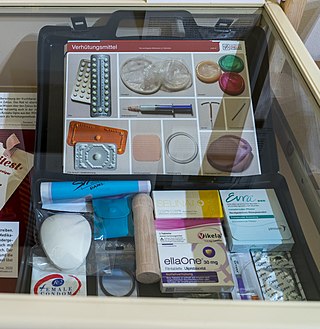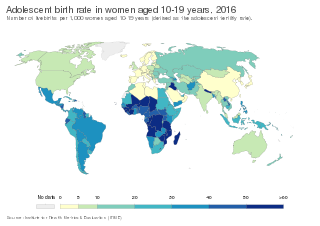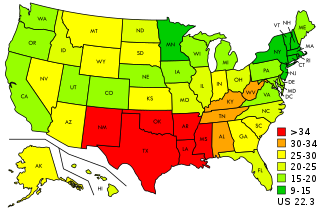Related Research Articles

Sex education, also known as sexual education, sexualityeducation or sex ed, is the instruction of issues relating to human sexuality, including human sexual anatomy, sexual activity, sexual reproduction, safe sex, and birth control, sexual health, reproductive health, emotional relations and responsibilities, age of consent, and reproductive rights.

Teenage pregnancy, also known as adolescent pregnancy, is pregnancy in a female under the age of 20.

Family planning is the consideration of the number of children a person wishes to have, including the choice to have no children, and the age at which they wish to have them. Things that may play a role on family planning decisions include marital situation, career or work considerations, financial situations. If sexually active, family planning may involve the use of contraception and other techniques to control the timing of reproduction.

Sexual and reproductive health (SRH) is a field of research, health care, and social activism that explores the health of an individual's reproductive system and sexual well-being during all stages of their life. Sexual and reproductive health is more commonly defined as sexual and reproductive health and rights, to encompass individual agency to make choices about their sexual and reproductive lives.
Adolescent sexuality is a stage of human development in which adolescents experience and explore sexual feelings. Interest in sexuality intensifies during the onset of puberty, and sexuality is often a vital aspect of teenagers' lives. Sexual interest may be expressed in a number of ways, such as flirting, kissing, masturbation, or having sex with a partner. Sexual interest among adolescents, as among adults, can vary greatly, and is influenced by cultural norms and mores, sex education, as well as comprehensive sexuality education provided, sexual orientation, and social controls such as age-of-consent laws.
The sexuality of US adolescents includes their feelings, behaviors and development, and the place adolescent sexuality has in American society, including the response of the government, educators, parents, and other interested groups.

Western and non-Western countries have distinctly different rates of teenage pregnancy. In Western countries such as the United States, Canada, Western Europe, Australia, and New Zealand, teen parents tend to be unmarried, and adolescent pregnancy is seen as a social issue.
Teenage pregnancy in the United Kingdom refers to the rate at which people under 20 fall pregnant in the United Kingdom. As of 2021, the rate of teenage conceptions in the United Kingdom was 5.226% percent of total conceptions, whereas 2.199% of all live births in the United Kingdom were to mothers under 20 years of age. The rate of teenage pregnancy is relatively high when compared with other developed countries; the only other Western countries with higher teenage pregnancy rates are the United States and New Zealand. A report in 2002 found that around half of all conceptions to under-18s were concentrated among the 30% most economically deprived population, with only 14% occurring among the 30% least deprived.

Birth control, also known as contraception, anticonception, and fertility control, is the use of methods or devices to prevent pregnancy. Birth control has been used since ancient times, but effective and safe methods of birth control only became available in the 20th century. Planning, making available, and using human birth control is called family planning. Some cultures limit or discourage access to birth control because they consider it to be morally, religiously, or politically undesirable.
Unintended pregnancies are pregnancies that are mistimed or unwanted at the time of conception, also known as unplanned pregnancies.

16 and Pregnant is an American reality television series that aired from June 11, 2009, to July 1, 2014, on the cable channel MTV. It followed the stories of pregnant teenage girls in high school dealing with the hardships of teenage pregnancy. Each episode featured a different teenage girl, with the episode typically beginning when she is 4+1⁄2 – 8 months into her pregnancy. The episode typically ends when the baby is a few months old. The series is produced in a documentary format, with an animation on notebook paper showing highlights during each episode preceding the commercial breaks. 16 and Pregnant has spawned five spin-off series: Teen Mom, Teen Mom 2, Teen Mom 3, Teen Mom: Young and Pregnant, and 16 and Recovering, which premiered on September 1, 2020.

Family planning in India is based on efforts largely sponsored by the Indian government. From 1965 to 2009, contraceptive usage has more than tripled and the fertility rate has more than halved, but the national fertility rate in absolute numbers remains high, causing concern for long-term population growth. India adds up to 1,000,000 people to its population every 20 days. Extensive family planning has become a priority in an effort to curb the projected population of two billion by the end of the twenty-first century.
Pregnancy when coupled with domestic violence is a form of intimate partner violence (IPV) where health risks may be amplified. Abuse during pregnancy, whether physical, verbal or emotional, produces many adverse physical and psychological effects for both the mother and fetus. Domestic violence during pregnancy is categorized as abusive behavior towards a pregnant woman, where the pattern of abuse can often change in terms of severity and frequency of violence. Abuse may be a long-standing problem in a relationship that continues after a woman becomes pregnant or it may commence in pregnancy. Although female-to-male partner violence occurs in these settings, the overwhelming form of domestic violence is perpetrated by men against women. Pregnancy provides a unique opportunity for healthcare workers to screen women for domestic violence though a recent review found that the best way in which to do this is unclear. Reducing domestic violence in pregnancy should improve outcomes for mothers and babies though more good quality studies are needed to work out effective ways of screening pregnant women.
Pregnancy is a potential result of rape. It has been studied in the context of war, particularly as a tool for genocide, as well as in other unrelated contexts, such as rape by a stranger, statutory rape, incest, and underage pregnancy. The scientific consensus is that rape is at least as likely to lead to pregnancy as consensual sexual intercourse, with some studies suggesting rape may actually result in higher rates of pregnancy than consensual intercourse.
Reproductive coercion is a collection of behaviors that interfere with decision-making related to reproductive health. These behaviors are often perpetrated by a current, former, or hopeful intimate or romantic partner, but they can also be perpetrated by parents or in-laws, or by policies of institutions or government. Coercive behaviors infringe on individuals' reproductive rights and reduce their reproductive autonomy.

Access to safe and adequate sexual and reproductive healthcare constitutes part of the Universal Declaration of Human Rights, as upheld by the United Nations.

Teenage pregnancy in the United States occurs mostly unintentionally and out of wedlock but has been declining almost continuously since the 1990s. In 2022, the teenage birth rate fell to 13.5 per 1,000 girls aged 15 to 19, the lowest on record. According to the Centers for Disease Control and Prevention (CDC), this decline is due to abstinence and the use of contraception.
Latin America is home to some of the few countries of the world with a complete ban on abortion and minimal policies on reproductive rights, but it also contains some of the most progressive reproductive rights movements in the world. With roots in indigenous groups, the issues of reproductive rights include abortion, sexual autonomy, reproductive healthcare, and access to contraceptive measures. Modern reproductive rights movements most notably include Marea Verde, which has led to much reproductive legislation reform. Cuba has acted as a trail-blazer towards more liberal reproductive laws for the rest of Latin America, while other countries like El Salvador and Honduras have tightened restrictions on reproductive rights.
Women's reproductive health in Russia refers to the set of physical, mental, and social health issues and services available to women in Russia. It includes the rights, laws, and problems experienced by women and their families regarding proper reproductive health. Women account for over half of the Russian population and are considered a vulnerable population due to political and social problems from inequalities in gender, age, socioeconomic status, and geographical location that affect access to comprehensive health care. As Russia struggles with a decreasing birthrate and increase in STIs, HIV, and poor reproductive health care, the need for government financed services and international programs is essential to successfully reach this vulnerable population. Currently, women in Russia access care through government funded free services, private insurance, and NGO programs.
Adolescent sexuality has been a topic observed and studied within the United Kingdom throughout the 20th century and in the 21st century. Associated organisations have been established to study and monitor trends and statistics as well as provide support and guidance to adolescents.
References
- 1 2 Senior, Kate A.; Chenhall, Richard D. (2008-01-01). "'Walkin' about at night': the background to teenage pregnancy in a remote Aboriginal community". Journal of Youth Studies. 11 (3): 269–281. doi:10.1080/13676260801946449. S2CID 145618721.
- ↑ "Archived copy" (PDF). Archived from the original (PDF) on 2015-07-14. Retrieved 2015-08-31.
{{cite web}}: CS1 maint: archived copy as title (link) - ↑ "3301.0 - Births, Australia, 2012". Abs.gov.au. 2013-10-24. Retrieved 2015-08-31.
- ↑ "3301.0 - Births, Australia, 2015". Australian Bureau of Statistics. Australian Government. Retrieved 5 July 2017.
- ↑ Australia), Child and Youth Health-CYH (South. "Teenage pregnancy" . Retrieved 2015-09-01.
- ↑ "Media Release - Australian women are now having children older than ever (Media Release)". Abs.gov.au. 2018-12-11.
- 1 2 3 4 "Teenage pregnancy - Better Health Channel". Archived from the original on 2015-09-23. Retrieved 2015-08-31.
- ↑ "3301.0 - Births, Australia, 2013". Abs.gov.au. Retrieved 2015-08-31.
- ↑ "4704.0 - The Health and Welfare of Australia's Aboriginal and Torres Strait Islander Peoples, 2008". Abs.gov.au. 2008-04-29. Retrieved 2015-09-01.
- 1 2 "Births and pregnancy outcome « Overview of Australian Indigenous health status 2014 « Health facts « Australian Indigenous HealthInfoNet". Healthinfonet.ecu.edu.au. Archived from the original on 2015-09-05. Retrieved 2015-09-01.
- 1 2 Memmott, Moran, Phill, Matthew (2001). "Indigenous settlements of Australia ". Ed. Australia: State of the Environment.
{{cite journal}}: CS1 maint: multiple names: authors list (link) - ↑ "Archived copy" (PDF). Archived from the original (PDF) on 2015-09-23. Retrieved 2015-09-01.
{{cite web}}: CS1 maint: archived copy as title (link) - ↑ Australian Bureau of Statistics, 2003. The health and welfare of Australia's Aboriginal and Torres Strait Islander peoples. Canberra : Australian Bureau of Statistics, Australian Government, Report 4704.0
- 1 2 3 4 Robson, Stephen; Cameron, Carolyn A.; Roberts, Christine L. (2006). "onlinelibrary.wiley.com.ipacez.nd.edu.au/doi/10.1111/j.1479-828X.2006.00597.x/abstract". The Australian and New Zealand Journal of Obstetrics and Gynaecology. 46 (4): 305–310. doi: 10.1111/j.1479-828x.2006.00597.x . PMID 16866791. S2CID 39354222.
- ↑ "Investigating an increase in teenage pregnancies in regional Australia | Croakey". blogs.crikey.com.au. 2013-01-24. Archived from the original on 2016-03-04. Retrieved 2015-09-02.
- ↑ Kildea, Sue; Kruske, Sue; Barclay, Lesley; Tracy, Sally (6 August 2010). "Rural and Remote Health Journal - View Article". Rural and Remote Health. 10 (3). doi: 10.22605/RRH1383 .
- 1 2 Jeon, Sung-Hee; Kalb, Guyonne; Vu, Ha (2011-06-01). "The Dynamics of Welfare Participation among Women Who Experienced Teenage Motherhood in Australia*" (PDF). Economic Record. 87 (277): 235–251. doi:10.1111/j.1475-4932.2010.00685.x. ISSN 1475-4932. S2CID 46140770.
- 1 2 3 Taft, Angela J.; Watson, Lyndsey F. (2007-04-01). "Termination of pregnancy: associations with partner violence and other factors in a national cohort of young Australian women". Australian and New Zealand Journal of Public Health. 31 (2): 135–142. doi: 10.1111/j.1753-6405.2007.00031.x . ISSN 1753-6405. PMID 17461004.
- ↑ "Teenage Pregnancies" (PDF). Unicef.org. 12 August 2019. Archived from the original (PDF) on 14 July 2015. Retrieved 31 August 2015.
- ↑ "Teenage Pregnancy - an adolescent health issue in Australia" (PDF). Eprints.utas.edu.au. Retrieved 12 August 2019.
- 1 2 "Teen Pregnancy Crisis". Dailytelegraph.com.au. 2006-12-13. Retrieved 12 August 2019.
- ↑ Waldron, Mary; Heath, Andrew C.; Turkheimer, Eric; Emery, Robert; Bucholz, Kathleen K.; Madden, Pamela A. F.; Martin, Nicholas G. (2007-06-01). "Age at First Sexual Intercourse and Teenage Pregnancy in Australian Female Twins". Twin Research and Human Genetics. 10 (3): 440–449. doi: 10.1375/twin.10.3.440 . ISSN 1839-2628. PMID 17564502. S2CID 8618809.
- ↑ Skinner, Hickey, Simon, Michael (2003). "Medical Journal of Australia". Current Priorities for Adolescent Sexual and Reproductive Health in Australia.
{{cite journal}}: CS1 maint: multiple names: authors list (link) - 1 2 Skinner, S. Rachel; Smith, Jennifer; Fenwick, Jennifer; Hendriks, Jacqueline; Fyfe, Sue; Kendall, Garth (2009-01-01). "Pregnancy and protection: Perceptions, attitudes and experiences of Australian female adolescents". Women and Birth. 22 (2): 50–56. doi:10.1016/j.wombi.2008.12.001. PMID 19179129.
- 1 2 Dyson, Mitchell, Sam, Alex (2005). "Sex education and unintended pregnancy". Are We Seeing the Results?.
{{cite journal}}: CS1 maint: multiple names: authors list (link) - 1 2 3 Skinner S.R; Smith J.; Fenwick J.; Hendriks J.; Fyfe S. & Kendall G. (2009). "Pregnancy and Protection". Perceptions, Attitudes and Experiences of Australian Female Adolescents. 22 (2): 50–56. doi:10.1016/j.wombi.2008.12.001. PMID 19179129.
- 1 2 Bainbridge, J (2010). "Teenage mothers in Perth". Australia Have Second Babies Too Quickly. 18 (10): 663. doi:10.12968/bjom.2010.18.10.78844.
- ↑ "Risk factors (AIHW)". Aihw.gov.au. Archived from the original on 2015-09-11. Retrieved 2015-09-03.